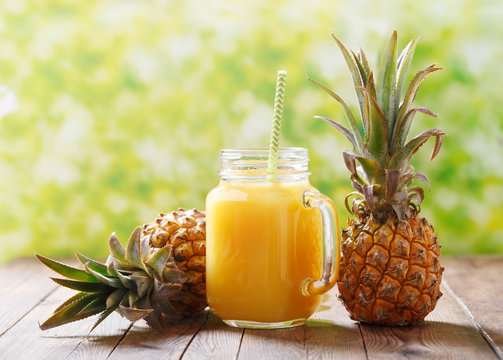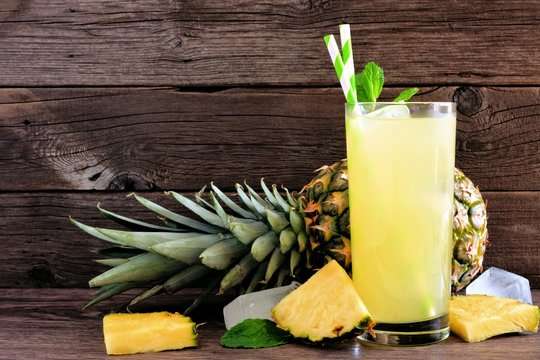How to choose, cut, and juice a pineapple perfectly are included in the recipe for pineapple juice. Fresh pineapple juice is tasty, revitalizing, and easy to make! It differs significantly from the bottled or canned kinds that fill the shelves of grocery stores since it is pure and free of additives. The secret to making the tastiest juice is to start with the best fresh pineapple you can find, but there are additional benefits.

Pineapple juice, whether it be a cold-pressed juice or one you make in your own blender, offers a great variety of reasons to appreciate it because of its many health benefits. The outcome is something that, without a doubt, will gratify your palate and improve your general well-being.
Homemade pineapple juice is created from natural, fresh pineapples and is tangy, sweet, and tart with the perfect amount of tartness. Every glass is packed with nutrients and is really simple to make. This beverage is a tropical treat!
I had to share my best homemade juice recipe before summer was over. You’ll be serving this juice for breakfast, lunch, supper, and any other time you need something energizing to wash down a satisfying meal. It really is reviving.
Pineapples are deliciously reviving, sweet, tangy, and just a tiny bit tart, making them the perfect ingredient for summer cooking! But surprisingly, I didn’t thought to mention the straightforward techniques I employ for making pineapple juice both with and without a juicer.
You can make fresh, homemade pineapple juice in 10 minutes without the use of additional sugar, additives, or preservatives found in the varieties sold at your neighborhood grocery shops using either a juicer, blender, or even a machine-free technique. Furthermore, fresh food allows for the best absorption of nutrients.
Fresh pineapple juice tastes great when added to smoothies, marinades, and other fruit mixtures. Even better, this healthy juice is loaded with numerous health advantages in addition to its mouthwatering flavor.

First impressions of pineapple and pineapple juice
Originally from South America, pineapples are now grown all over the world in warm areas. Thailand is where most of the world’s supply is cultivated.
Vitamins and minerals are abundant in pineapple. Additionally, bromelain, an enzyme that has been used for centuries to cure a variety of illnesses, is the only significant dietary supply found in pineapples. Research conducted recently on the effects of bromelain supports a number of the potential health advantages of pineapple.
One serving of pineapple juice contains a significant amount of these nutrients. Most pineapple juice includes little to no additional sugar because it is naturally delicious. Ascorbic acid, another name for vitamin C, is frequently added to pineapple juice purchased from stores. Although ascorbic acid is added to pineapple juice, which already contains a lot of this immune-boosting vitamin, it also helps maintain the juice’s flavor and color.
Pineapple juice is also simple to create at home. Just make sure to use a completely matured pineapple because eating it raw can make it harmful.
Although they are now available in stores all over the world, pineapples were once utilized as a symbol of riches and high status for hundreds of years. Bottled pineapple juice is also widely available in stores and is frequently served freshly squeezed in cafes and restaurants.
Pineapple meaning
In their native Brazil, pineapples were once a symbol of friendliness and hospitality. In order to scent the air and greet guests, pineapples were placed on house doors.
Pineapples are also seen as a symbol of riches, fortune, and luck in China. It is frequently utilized during festivities for occasions honoring deities or holidays like the Lunar New Year.
Whether or not you think symbols have power, one thing is certain: pineapples are nutritious, delectable, and adored all across the world. And for that reason, my friends, I adore pineapples.
How safe is pineapple juice?
Benefits of Pineapple Juice for Health
A variety of vitamins and minerals found in pineapple juice helps strengthen your immune system. It has a lot of vitamin C, which can help your body fend off the common cold. Additionally, it contains enzymes that have been demonstrated to stimulate a strong immunological response.
Other health advantages of consuming pineapple juice have been discovered by research:
Properties that Reduce Inflammation
Bromelain, an enzyme found in pineapple juice, stimulates your body’s natural ability to combat pain and reduce swelling. It’s used to treat inflammation and sports injuries and might be successful in easing osteoarthritis symptoms.
Heart Wellness
In addition to supporting healthy blood flow and lowering your risk of heart disease, bromelain may also dissolve blood clots and cholesterol buildup in your arteries.
Relieving Cold and Allergies
Bromelain, an enzyme found in pineapple juice, may also help to thin mucus that causes chest or sinus congestion. In addition to being anti-inflammatory, pineapple juice may help with allergy and common cold symptoms.
These characteristics have motivated scientists to investigate its potential to treat asthma. Studies have linked bromelain consumption to a decrease in airway inflammation, a key asthma symptom, however further research is needed.
Clear vision
Pineapple juice’s vitamin C and antioxidant concentration may lower your risk of eyesight loss. High quantities of vitamin C, beta-carotene, and vitamin A found in pineapple juice can lower the risk of macular degeneration, a condition that can lead to cataracts and vision issues as people age.
In addition, pineapple juice was found in a research to lessen the occurrence of eye floaters, which are tiny spots or forms that impede vision.
May Promote Digestion
As a result of the digestive enzymes in pineapple juice, you may have less gas, bloating, and constipation. Additionally, bromelain contains antimicrobial qualities that can lessen gut inflammation and shield your gut from bacteria like E. coli that cause diarrhoea.
Since studies have centered on the effects of concentrated bromelain higher than the quantity found in pineapple juice, more research is required to establish these digestive effects.
Risks that Pineapple Juice Might Possess
People with specific medical conditions may experience health issues due to pineapple juice’s high nutrient content.
Find out if pineapple juice is a healthy supplement to your diet by speaking with your doctor. Before consuming pineapple juice, take the following into account:
Allergies
A pineapple allergy can result in hives, a rash, or breathing problems in some people. If you have these symptoms after eating pineapple, stay away from pineapple juice.
Stomach issues
High vitamin C intake may result in heartburn, diarrhea, or nausea. In the same way, consuming too much bromelain might result in diarrhea, heavy menstrual flow, or a skin rash.
The acidity of pineapples may make heartburn symptoms worse in those who suffer from gastroesophageal reflux disease.
Toxicity
Only pineapple juice that has fully ripened pineapple should be consumed. Human toxicity from unripe pineapple can result in life-threatening diarrhoea and vomiting.
Renal disease
Before consuming pineapple juice, those with kidney illness should check with their doctor to be sure the potassium content is appropriate for their diet.
Dental decay
The sugar and acid in pineapple juice can erode tooth enamel and cause cavities.

For what purpose?
In comparison to bottled juice, fresh juice offers more vitamins and minerals. Additionally, homemade juices have higher levels of antioxidant, antiviral, and anticancer qualities than commercial juices, which are lost during bottling.
In addition, some canned or bottled types are sweetened with sugar, which reduces some of the nutritional advantages of making your own fruit juice.
Juice from the store could never compare to the taste or advantages of this homemade elixir. More nutrients are present in pineapple juice that is produced at home.
However, since the body does not have to work as hard to break down fiber in the digestive tract, not obtaining the fiber may really be a positive thing.
You can feel an energy boost fast after drinking fresh juice since the nutrients can enter the body right away and get to work right once.
Of course, not every juice has the same health advantages. Without a question, some are superior to others. In actuality, there are a few reasons why homemade juice is superior to store-bought.
Contrast between cold-pressed and blended juice
There are advantages to every juice kind. Because it keeps the nutrients of the fruit in the absence of heat, cold-pressed juice is unquestionably the best and even better than the kind of juice you can create in your blender. All of the vitamins, minerals, enzymes, and nutrients are received in full.
Selecting a pineapple
Knowing what to look for makes choosing the best pineapple easier than it might seem. Utilizing your senses of sight, smell, and touch will ultimately result in fruit that has the best flavor.
It is important to note that, at first appearance, a pineapple’s exterior hue does not necessarily indicate how ripe it is. A green pineapple can also be ripe, even though some pineapples turn yellow at the height of their ripeness.
In general, you should seek out pineapples with some yellow, especially at the base. It is better to stay away from pineapples that have turned orange because this indicates that they have passed their prime and may now taste a little fermented.
In addition, pay attention to the color of the leaves, which should be a vivid green and indicate freshness.
The pineapple should then be picked up so that you can feel it. It should be firm, weighty for its size, and have a very slight yield when applied pressure. Soft patches, which could be a symptom of bruising, should not be present. On the opposite extreme, a pineapple that is excessively firm could be underripe and not particularly flavorful.

More advice
When purchasing a fresh pineapple, choose one that smells good. It is usually not the greatest taste if it has no aroma at all. On the other hand, if it smells like vinegar, it has definitely gone too far.
The general rule is to choose a pineapple that smells fresh and fruity, as that is how you want it to taste. Unripe pineapple should not be consumed because it is harmful to humans and has a poor flavor.
When buying pineapple from the grocery store, there is probably minimal risk involved, but it is advisable to pick a pineapple that exhibits at least some signs of ripeness.
A fresh pineapple being cut
A cutting board, a sharp chef’s knife, and a pineapple can be simply and securely chopped, despite how intimidating it may seem to a novice.
The pineapple can first be turned on its side and the top and bottom sliced off to reveal the flesh. By doing this, you’ll be able to stand the pineapple upright and start to take off its prickly shell. If your pineapple is able to stand on its own, you can also skip this stage.
Make a large incision from top to bottom, following the pineapple’s shape as a guide, being sure to take out the eyes.
You can chop again if you haven’t gone far enough. After making this initial cut, make parallel cuts all the way around the pineapple until it is entirely clear.
Cut the pineapple in half, passing through the core directly, and then again in the same manner, cutting it into quarters. The fruit can now be gently divided into four long quarters and four pieces of the core by carefully cutting between the flesh and the core along the length of the fruit.
Is the center of a pineapple edible?
The answer to your question about whether the core is genuinely edible is yes. Although it is rougher and dryer than the rest of the pineapple flesh, it is really rather tasty when chopped into smaller, thinner pieces.
Despite being less sweet, it is important to note that it is quite high in fiber, manganese, bromelain, and vitamin C. You can eat the core for its anti-inflammatory benefits even though it’s not the best for juicing. Additionally, it aids in better meal digestion and the breakdown of proteins.
However, consuming a lot of pineapple core might hurt and numb the tongue. Therefore, always consume it in moderation with a dash of salt. I normally juice the pineapple with the core, so I like to add little salt and a slice of ginger to prevent discomfort.
Spicing
Any type of fresh pineapple juice is undoubtedly tasty, but imagine how great it could be when combined with black pepper, fresh ginger, Himalayan salt, and other seasonings. Fresh mint is an optional addition that will raise it even higher.
Consume the pineapple juice as soon as possible to get the maximum flavor and vitamins before it starts to oxidize.
Recipe components
Pineapple: Your family will have enough cool juice from one or two fresh, juicy pineapples.
Pineapple is already rather sweet, but you can make it even sweeter by adding a few tablespoons of table sugar. You can skip the sugar if you like fruit drinks that are entirely natural.
Lemon, mint, or pineapple pieces are all attractive (and delicious) garnish options for this juice.
Making pineapple juice
Pick ripe, fresh pineapples every time. Unripe pineapples cause stomach distress. Take off the skin a little bit inside. Cut them into pieces that will fit in your blender.
Add them, along with the salt, black pepper, and fresh ginger that are optional, to the blender or juicer. Since all of the ingredients are merely estimates, you can start out with fewer.
Pour some water or coconut water to make mixing easier. Once more, don’t use a lot of water.
Blend until foamy and well-combined.
Over a pitcher or bowl, place a filter. the mixed pineapple juice into a cup.
To ensure that the fluids travel through the strainer, keep stirring with a spoon. To fully extract the juice, press the pulp against the sieve.
Serve the pineapple juice right away.
In addition, I use a slow juicer. Just insert the sliced pineapple chunks into the juicer funnel after turning on the juicer. The pulp naturally separates from the juice. One giant pineapple needs to be juiced before the pulp is removed. then move on to the next.
Taste is where there is a difference. Since no additional liquid is added, slow juicer-produced pineapple juice is pure and delicious.
Here’s what I think will be new about pineapples and how to make pineapple juice. I hope these are what you are looking for. Good luck with this recipe!
